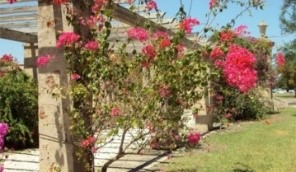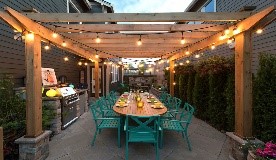03 Mar 2017
We’ve Got You Covered

Pergolas, arbors, and patio covers remain popular landscape features and can set the footprint for additional living space. They block the sun while still allowing air circulation, provide architectural interest, and can add value to your home. Because the terms are often used interchangeable, here are the definitions for each type of structure and some questions to consider when selecting the right shade solution for your home:
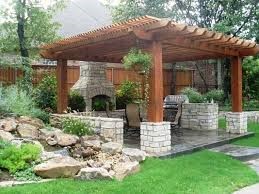
Photo: Gaby Hartley Corder
Pergola: A freestanding outdoor structure of any size that uses joists and rafters for shade.
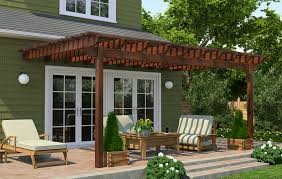
Photo credit: NT Windows
Arbor: An outdoor structure of any size that uses joists and rafters for shade with at least one side attached to a home or another building.
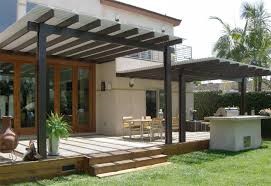
Photo: Furniture Fashion
Patio Cover: A freestanding or attached outdoor structure of any size, open on the sides, with framing and a roof that protects from rain and the elements.
- Freestanding or Attached?
This question is the best way to start distinguishing between these outdoor structures. If the project is freestanding, then it is either a pergola or patio cover. A patio cover can also be attached. Arbors will have posts or columns on one side and be connected to a home/building on the other side. This can be a point of confusion because many refer to arbors as being freestanding arches or gateways to a garden or backyard. However, when you say the word “arbor” to a professional builder they assume the structure will be attached to your house or another structure.
- Roof or Rafters?
Pergolas and arbors use posts connected by joists and rafters for shade and stability, but those rafters don’t keep rain or the elements out. Even if fabric or other materials are in between the rafters, if rain can get in from the top then it is considered a pergola (if freestanding) or arbor (if attached). Patio covers consist of framing over-laid with shingles or a roofing material to keep the elements out.
- How Big is the Structure?
There are no size guidelines differentiating arbors, pergolas, and patio covers. All three structures can be small or expansive. Some may argue that smaller freestanding structures are considered arbors, but unless the structure is attached to a home or building it is still considered a pergola.
It is also important when determining placement, to evaluate how much sun/shade will hit it during the day, and to make sure it isn’t blocking a key view while inside the home and the continues to offer the desired view while inside the pergola.
- Select the Materials
There are four reliable materials that are often used for building pergolas, arbors and patio covers. The choice is based on the size, style, and purpose of your structure as well as your taste and budget. A combination of these materials also works well.
- Wood
The most commonly used material for building outdoor structures is weather-resistant wood such as cedar, redwood, mahogany, or teak. These woods are preferred as they are a sturdy, decorative, and they contain natural oils which make them resistant to rot, decay, termites, fungi, and insects as well as warping and shrinking. Regardless of the type of wood, it should still be sealed to provide extra protection against moisture from rain and dew and to reduce chipping and cracking.
- Metal

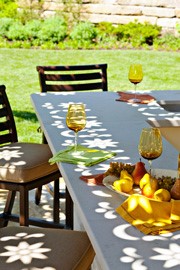 Metal is considered the most durable of the many materials used for outdoor structures. The main deterrent to using metal is rust. Galvanizing or painting the metal will impede rust and keep it looking new. Most often metal is thought of when a contemporary or minimalist look is desired, however, Parasoleil offers a unique line of architectural metal panels to filter and sculpt light that are not only engineered to withstand the elements but are profoundly artistic. They can be used to shade special architectural places and offer patterned nuance to structural detail or create visual breaks, barriers, and privacy.
Metal is considered the most durable of the many materials used for outdoor structures. The main deterrent to using metal is rust. Galvanizing or painting the metal will impede rust and keep it looking new. Most often metal is thought of when a contemporary or minimalist look is desired, however, Parasoleil offers a unique line of architectural metal panels to filter and sculpt light that are not only engineered to withstand the elements but are profoundly artistic. They can be used to shade special architectural places and offer patterned nuance to structural detail or create visual breaks, barriers, and privacy.
- PVC or Fiberglass
PVC is also a good option for outdoor structures. Using a thick type will provide a weather-resistant material that requires little maintenance. Fiberglass and plastic roofs are fairly inexpensive and are available in lightweight panels of different sizes that can easily be cut down to size as needed. Fiberglass may be harder to find but most fiberglass materials are made by using recycled materials so they offer the option of using a green material to your project.
- Fabric
One of the more versatile options for roofing is outdoor fabric. They offer sun protection, like other roofing options, and in addition, fabric canopies and fabric sails are a great way to add color and style to your patio. They are easy to install and remove and are just as durable as other options. Fabrics from Sunbrella, Coolhaven, and others will not rot or mildew and are typically covered by a 10-year limited warranty.
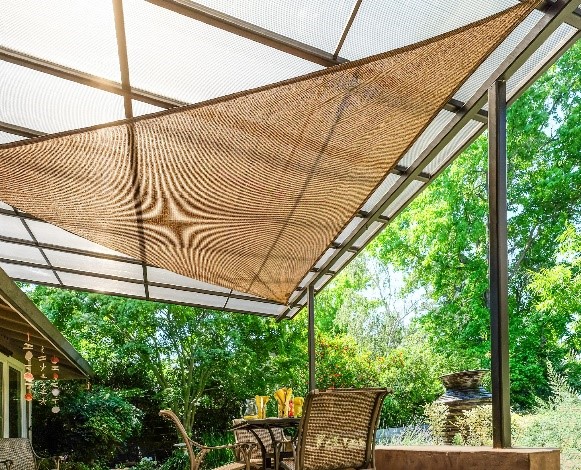
Photo: Charlie Gibson Photography
Hammerschmidt Project
In one of our recent projects in Los Altos, we designed a pergola with a welded metal frame, containing eight removable plexiglass panels that slide into a custom-designed metal track. Underneath the panels, a durable fabric sail was added to provide addition sun protection and reduce heat in the summer months. It is easily retractable during the winter months to allow more natural light to enter the house.
Wow Factors
Regardless of where your structure is placed, incorporating add-ons into the structure will provide a wow factor and enhance your outdoor experience. Installing up-lights and/or down-lights will make the space usable both day and night. Climbing plants or vines, growing alongside, up the columns, and over the top, soften the structure creating a more natural look. Adding a misting system—running it internally through the beams—provides cooling relief in the heat and a tropical ambiance to your backyard. To complete your outdoor room, consider mounting a TV and sound system to the design.
June Resources

Visit ShadeFX for ideas:
Best vines for pergolas and lighting ideas to illuminate your outdoor space
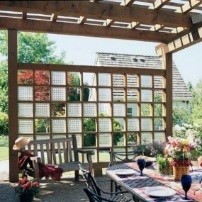 Better Homes and Gardens:
Better Homes and Gardens:
11 Ideas for Landscaping with a Pergola
Fine Homebuilding explains the difference between a trellis, an arbor, and a pergola.
![]()
Visit Houzz for more inspiration and examples of arbors, pergolas, vines, lighting and more.
02 Oct 2016
Make a Grand Entrance
 When designing the perfect house, there is one area that is often overlooked –the entry/foyer of a home. The entry experience is important for a few reasons: It is a transition from the public domain of the street to your private domain of your home. It’s the “middle place” to let one adjust and ease into other rooms that may be more private. It’s the first thing you and your guests see as you enter your home. You want it to be warm and welcoming, to reflect your personal style and make you feel happy and comfortable as you walk through the door. This space sets the tone for the rest of your home.
When designing the perfect house, there is one area that is often overlooked –the entry/foyer of a home. The entry experience is important for a few reasons: It is a transition from the public domain of the street to your private domain of your home. It’s the “middle place” to let one adjust and ease into other rooms that may be more private. It’s the first thing you and your guests see as you enter your home. You want it to be warm and welcoming, to reflect your personal style and make you feel happy and comfortable as you walk through the door. This space sets the tone for the rest of your home.
Just as you would evaluate and design for every other room in your house, the entryway deserves just as much attention. Here are some ideas to consider.
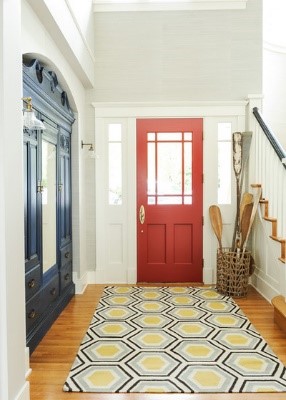 Personalize the space. Decorative accessories, such as artwork or family portraits etc. will help to reflect your personal taste. Display a collection of mementos from your travels. Even if your space is small, you can make a large impact. Experiment with eye-catching wallpaper and bright patterns. If you’d rather keep your walls neutral, opt for a colorful hallway runner. Just make sure it is hard-wearing to accommodate this high traffic area.
Personalize the space. Decorative accessories, such as artwork or family portraits etc. will help to reflect your personal taste. Display a collection of mementos from your travels. Even if your space is small, you can make a large impact. Experiment with eye-catching wallpaper and bright patterns. If you’d rather keep your walls neutral, opt for a colorful hallway runner. Just make sure it is hard-wearing to accommodate this high traffic area.
Lighting here is just as important as any other room. Make the most of natural light by selecting a front door with sidelights or a transom. Installing a skylight can also make a world of difference to small spaces. Depending on the height of your ceilings a large hanging pendant or chandelier adds drama and can set the tone and style of the adjoining rooms. For larger hallways, scones and uplights are both practical and stylish and perfect for giving hallways that welcoming feel.
Storage and “drop zone” features are critical in preventing the entry from becoming a dumping ground for shoes, backpacks, coats, and all that is needed to get out the door in the morning. With a few decorative pieces, such as a side table, coat rack, or storage unit, clutter can be kept to a minimum and keep you organized. A bench is useful for putting on and taking off shoes and may offer hidden storage for out of season items.
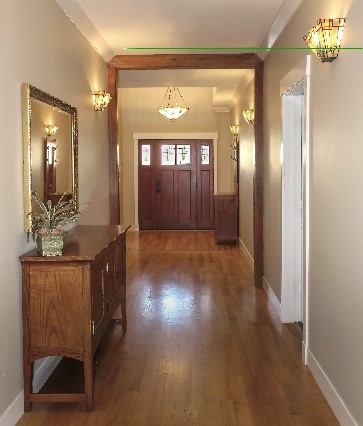 One of our favorite entries is this beautiful one we built for this Craftsman whole house remodel in 2014. From the moment you enter, you feel welcomed and have a sense of the entire home.
One of our favorite entries is this beautiful one we built for this Craftsman whole house remodel in 2014. From the moment you enter, you feel welcomed and have a sense of the entire home.
Beginning with the elegant, handcrafted front door, the natural light shines through the door lights and architectural side light panels.
A hanging pendant complements the stained glass door panels and adds color and artistic interest.
Because this is the clients’ “forever” home, the hallways are extra wide creating an open, spacious feeling while allowing for “aging-in-place” in the future.
The wood floors are embellished with a simple yet pronounced design.
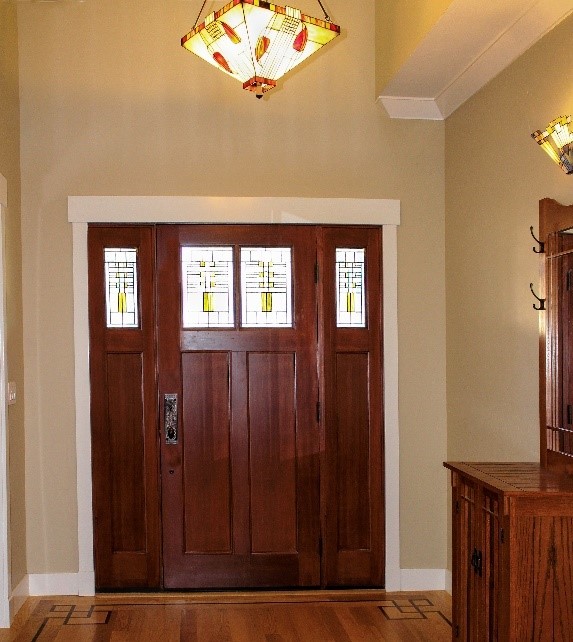 Placing the hutch, close to the front door provides a convenient and organized place for keys, and other items necessary for arrivals and departures for the day.
Placing the hutch, close to the front door provides a convenient and organized place for keys, and other items necessary for arrivals and departures for the day.
Midway down the hall, a darker trim is used to break up the space and add interest.
And finally, aside table indicates the entry into of the rest of the home and provides the perfect place to display seasonal items or personal treasures.
More photos of this project can be found on our website under Projects/Whole House Remodels/Craftsman, Campbell CA.
Resources

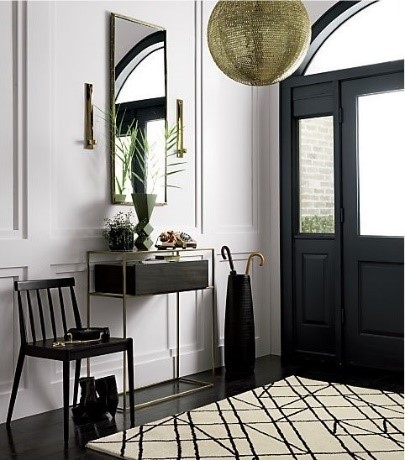 Stay organized as soon as you step inside, with modern entryway storage furniture at CB2. Hang up your jacket on one of their unique coat racks and keep shoes and bags tucked away in a stylish storage bench or sleek credenza. Perfect for foyers, mudrooms, and hallways, their entryway furniture and accessories will stop clutter right at the front door.
Stay organized as soon as you step inside, with modern entryway storage furniture at CB2. Hang up your jacket on one of their unique coat racks and keep shoes and bags tucked away in a stylish storage bench or sleek credenza. Perfect for foyers, mudrooms, and hallways, their entryway furniture and accessories will stop clutter right at the front door.
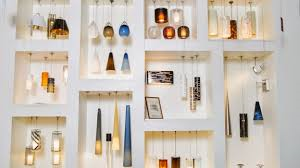 Stanford Electric Works has a great new showroom at 126 San Antonio Circle in Mountain View, just a few short minutes off the Bayshore Freeway. They have a large selection of quality and stylish products that’s perfect for all homeowners. Find out more on their website.
Stanford Electric Works has a great new showroom at 126 San Antonio Circle in Mountain View, just a few short minutes off the Bayshore Freeway. They have a large selection of quality and stylish products that’s perfect for all homeowners. Find out more on their website.
![]()
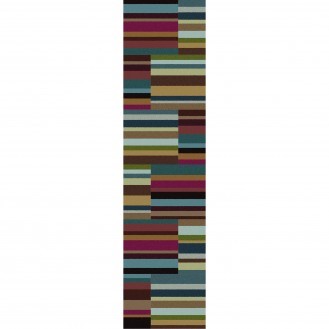 Make a statement with FLOR Carpet Tiles. A modular and sustainable design process. Customize to your heart’s content. You can get exactly what you want – the right size, the right style, one square at a time.
Make a statement with FLOR Carpet Tiles. A modular and sustainable design process. Customize to your heart’s content. You can get exactly what you want – the right size, the right style, one square at a time.
01 May 2014
The Front Porch is Back
During the last few decades, the front facade of most new suburban homes was dominated by a garage. This placement of the garage was convenient for homeowners who wanted to quickly enter their homes after work and put all the noise and confusion of the day behind them. If they wanted to spend time outside, they went to their private deck or patio out back. Family life centered around the backyard.
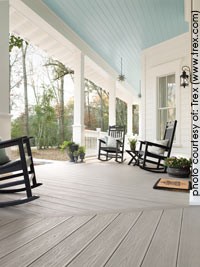 Today’s families are happily rediscovering the advantages of the front porch. A front porch provides opportunities for people to meet and connect with their neighbors, often developing meaningful relationships. These shared experiences tie neighborhood families together and help create a sense of community.
Today’s families are happily rediscovering the advantages of the front porch. A front porch provides opportunities for people to meet and connect with their neighbors, often developing meaningful relationships. These shared experiences tie neighborhood families together and help create a sense of community.
Read More
01 Nov 2013
Home for the Holidays
In anticipation of holiday visitors and guests, have fun sprucing up your home to make their visit more enjoyable with things that you’ll enjoy throughout the year. Whether you have a dedicated guest room or need to convert an office into a bedroom for holiday guests, here are a few ideas to get you started.
Begin with your home’s exterior
Refresh Your Entry
Your home’s entrance makes an important first impression. Refresh your entry with a new coat of paint on the front door. And if the trim is starting to look weathered, scrape and repaint those areas as well.
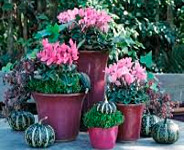 Deck Out Your Planters
Deck Out Your Planters
While you have the paint can open, paint planters and window boxes in the same color as your trim or door. Then, add some seasonal color by filling the window boxes with annuals such as Cyclamen, primroses, stock and decorative kale.
Another idea is to use real or artificial holly, pomegranates, birch sticks and greenery to create a holiday planters. Top them off with a string of tiny white lights to brighten the front entrance.
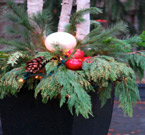 Clear the Clutter and Light the Way
Clear the Clutter and Light the Way
Remove any clutter from your front entrance and pick-up leaves and other debris by the front door. Test bulbs in your exterior light fixtures to ensure they safely illuminate pathways and steps. Add a new doormat that extends a warm welcome to your visitors.
Then move into the interior
 Add comfort
Add comfort
Wondering how you are going to turn your home office into a B&B for your house guests? Consider a versatile Wall Bed/Murphy Bed. Wall beds open to a normal resting height and accommodate any standard mattress. They are space savers, safe and easy opening and no comfort is lost ! For more ideas and wall bed options, check out our trusted friends at Valet Custom Cabinets and Closets.
 And that Special Touch
And that Special Touch
You can always count on Martha Stewart for ideas to make people feel welcome and to ensure that their time spent with you is memorable.
An easy example she gives is to keep sets of guest towels together, bound with twill tape or ribbon. When visitors arrive, just transfer a stack from linen closet to guest bedroom.
Click here for a checklist that will help you impress your guest.
01 Jun 2013
Create an Outdoor Living Space
According to a recent Home Design Trends Survey by the American Institute of Architects, as the economy continues to improve, outdoor living environments remain one of the prime areas homeowners are focusing on when improving their homes.
Read More
16 May 2013
Bringing the Outdoors In
Spring has sprung and the garden is full of color. After a long winter, it is refreshing to bring those colors in to expand the visual space and revive our spirits. Here are some ways to bring the outdoors in:
Read More
01 Nov 2012
Make a Grand Entrance
We’re entering the season for parties and holiday get-togethers at your house. As visitors make their way up the walk, what kind of first impression does your front entryway make? If you’re thinking about replacing your doors, you’ll want to read our discussion below.
The front entry to your home is one of the first things a visitor notices. The doorway, as the home’s focal point, will greatly influence the perceived value of your home. It also becomes an opportunity for you to make a unique statement about the character of your home.
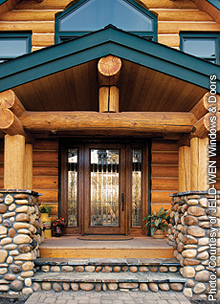 A Material Choice
A Material Choice
Exterior doors are generally available in three different materials: wood, fiberglass/composite, and steel. As you are making your choice, factors to consider are cost, endurance, climate, energy-efficiency, usage and finish. If you prefer natural wood because of the warmth of its appearance, keep in mind that wood requires regular maintenance to protect it from the weather. Today’s manufactured wood doors usually have an engineered wood core that provides stability. Fiberglass/composite and steel doors are designed to withstand the elements and provide easy-care. In addition, these doors can convincingly resemble wood grain.
The Insulation Factor
Doors are an important part of the overall insulation picture for your home. A flimsy, poorly fit door can allow a regular, unwelcome flow of cold or hot air into your home, negatively affecting your energy bills. Your fiberglass/composite or steel door should have an energy-efficient and environmentally-safe core. Consider purchasing an entry door system with the components–such as hinges and weather stripping–all designed to work together efficiently.
The amount and kind of glass used makes a difference. You may want a lot of glass to improve your view, or to increase your indoor lighting. On the other hand, security and privacy may be more important to you, and therefore you want a door with minimal glazing. Either way, choose an ENERGY STAR qualified door with a double layer of glass, a low-E coating, and argon gas between the glass panes.
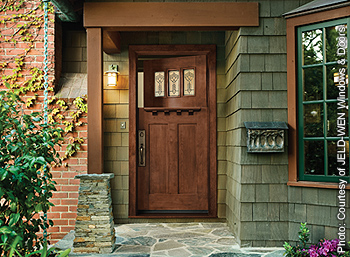
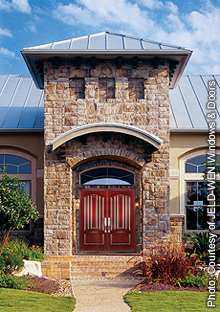 Decorate with Doors
Decorate with Doors
Use your doors as a design element, coordinating them with the architectural style of your home to make the whole picture attractive and appealing. Doors come in virtually every style, from Victorian to Rustic. Glass can be etched, beveled, leaded, frosted, stained, textured or tinted. Obscure glass is valued for transmitting light and maintaining privacy at the same time. Doors may have inserts in many shapes. Large glazed doors, often with sidelights and transoms, are currently very popular. Some doors are painted, some stained, and some have baked-in color.
By carefully selecting your entry door, you can create a welcoming appearance for your entire home, while adding value and energy savings at the same time.
24 Oct 2011
Livable for a Lifetime
Greetings!
According to an ASID (American Society of Interior Designers) survey of U.S. homeowners, most Americans (82%) want to remain in their homes as they age, even if they should require assistance and care. Is your home designed to provide a comfortable and functional environment for every stage of your life? We are sharing some ideas to help make sure it is.

If you are nearing retirement age, you are probably looking forward to all the activities you have not had time for in the past. Maybe you would like to plan more sleepovers for the grandkids. Or perhaps you and your friends would like to start a cooking club that meets in each other’s homes. If you are like most people belonging to the boomer generation (1946-1964), when you imagine your future, it generally includes being active, doing the things you enjoy, and staying in your own home. Boomers usually like to avoid thinking about aging and how it might affect their active lifestyle.
It’s a good thing, however, to start the process now of remodeling your home so it will meet your future needs with comfort and style. As your home is remodeled, modifications that accommodate all physical limitations can be seamlessly incorporated into the design without detracting from your home’s beauty. This is what is known as “barrier-free” design or “universal design.” Without certain modifications, even the most luxurious of homes could become a barrier to your freedom of movement, should you ever have an accident or require surgery.
Consider your bathroom. If you ever are confined to a wheelchair, will you be able to bathe yourself independently? Here’s a check-list of items you may want to include as you upgrade to a barrier-free bathroom:
- Zero-threshold shower with a seat
- Grab bars inside and outside the shower
- Adjustable-height hand shower with thermostatic controls
- Wide-decked bathtub
- Comfort-height toilet
- Electronic hands-free faucets
- Knee space under the vanity or wall-mounted sink
- Rocker light switches or motion-detector light switches
- Lever handles on doors

An additional benefit is that these kinds of products are available from many manufacturers today in stylish designs and luxury finishes that enhance the look of your bathroom, rather than make it appear institutional. The Wave grab bar from Great Grabz (photo above) provides a sophisticated look, yet can hold over 250 lbs. of force. Also pictured (photo left) is Jason’s sleek zero-threshold shower base that includes an integral seat and a slip-resistant textured floor.
Take a look around the rest of your home and think about whether you will be able to move from one area to another safely, independently and comfortably in the years to come. If you prepare ahead of time by remodeling your home using universal design guidelines, you can look forward to enjoying a home that is livable for a lifetime!
Pleased to Be Here
“I’m very pleased to be here. Let’s face it; at my age I’m very pleased to be anywhere.” George Burns
Aging in place – doesn’t the idea of it make you queasy? I envision someone slowing to a grinding halt and keeling over as gravity overcomes inertia. I know what it’s meant to suggest – the ability to live in one’s home – wherever that might be – for as long as confidently and comfortably as possible, but couldn’t they have called it something more appealing?
The National Association of Home Builders (NAHB) reports modification for aging in place is the fastest growing segment of the residential remodeling industry. A “Fixing to Stay” survey of 2,000 persons aged 45 and over, conducted by the American Association of Retired Persons (AARP) found that 70% of the respondents had made at least one modification to their home to facilitate their ability to remain in the home as they aged. The most common modifications were:
- Installing additional lighting in hallways and stairwells
- Placing living quarters (bedroom, bath, kitchen, laundry) on the main floor
- Replacing knobs with levers on doors and faucets
- Adding handrails and/or grab bars
You can find a helpful Aging in Place Checklist for Home Remodeling on the NAHB site.
Incorporating universal design principals to make a home safer, more comfortable, and increase the likelihood of remaining independent, does not have to result in an unattractive, clinical environment.

Walkway before, without the ramp
As with every remodeling project, our goal is to assure that the results are not only functional, but aesthetically-pleasing. Here are two examples of recent work that achieve this goal. A past customer asked us to make changes to their home to make it safer and more accessible for an aging parent who was about to move in with them. The parent uses a walker and would havedifficulty maneuvering up the steps to enter the home. Initially, the plan was to install a ramp near a side door so it wouldn’t negatively impact the home’s curb appeal. However that location proved to be logistically-inconvenient. The home’s circularfront driveway provides an ideal location for picking-up

Walkway after, with ramp installed
and dropping-off passengers. To assurethe ramp blended seamlessly into the existing landscape, we created it using the same pavers installed on the driveway and porch so it looks like it was part of the original design and not an afterthought. Now the only challenge will be keeping neighborhood skateboarders away! Another project, a master bathroom remodel, was completed for a couple who wanted to remain in their home as long as possible. Though neither of required a walker or a wheelchair, they wanted to assure maximum accessibility to the shower and toilet area, in case one of them was in a wheelchair in the future.
At the same time, they wanted to assure that the remodel increased the home’s resale value. We designed a curb-less travertine stone shower with a built-in seat. It also includes a flexible shower and grab bars for safety. A fixed glass-block wall separates the shower from the barrier-free comfort-height toilet. The choices for accessible fixtures have increased dramatically in the last few years. Many manufacturers such as Kohler now make innovative products that provide extra stability, ease-of-use, and comfort, without compromising beautiful design. Many updates, such as grab bars, ramps, and increased lighting do not require a long lead times, nor are they large budget items. Contact us for more ideas on how to make your home accessible and safe.

Curb-less shower w/ grab bar and seat

Barrier-free, comfort-height toilet
27 Jun 2011
Outdoor Rooms
Greetings!
For a culture that spends much of its work day inside, having a connection to the outdoors while at home is very desirable. Have you ever thought about creating an outdoor room for your home? Read below for ideas on how to make the most of the outdoor living at your home.
After a day spent indoors, the freshness of an outdoor living retreat can help you unwind, de-stress, and enjoy the natural surroundings. In California, where the temperate Mediterranean climate allows for outdoor living in three seasons, a new outdoor room can be a cost-effective extension to the living space of your home and the perfect spot for relaxing with family and entertaining friends.
Determine the Best Use of Your Outdoor Space
In thinking about your room, the first thing to decide is how you will use it. Do you want to relax, eat, or entertain, in your room-or all three? It’s also important to decide how large the room will be and how the space will be defined. These decisions are also predicated on the need for protection from the elements – sun and wind in California.

Ceilings, Walls, Floors
A pergola, trellis, or awning will help define the space at the same time it provides shade on a sunny day. Adding permanent walls made from stucco, concrete, wood or brick, or free-standing walls provide protection, direct your eye to the room and route accordingly. Other room-defining options include “framing” the room with plants growing on vertical trellises that provide a visual boundary but offer a view of what’s behind or movable planter walls that can be reconfigured as needed. An alternative to creatingan entire outdoor kitchen is to add a wall of French doors or a movable wall such as made by NanaWall. Then, when desired, the whole wall can be open to the outside and your existing kitchen is open to the outside.

Furnishings and Fabrics
As you plan your outdoor room, choose furnishings that are intended for outdoor use. Furniture cushions should be covered in fabrics that resist water,stains, and fading. Some newer cushions are offered in “fast dry” styles that prevent water from pooling on your seats in the event of a summer shower. Outdoor drapes are now widely available and can be used to block sun or wind, provide privacy for an afternoon snooze, and add visual interest.
Outdoor Kitchens
An outdoor kitchen can be as simple as a free-standing grill or as elaborate as a full kitchen complete with a grill, refrigerator, dishwasher, sink, cabinetry, and countertops. When shopping for appliances, keep in mind that they must meet outdoor electrical and plumbing requirements and should be wind, rain, and rust resistant.

Furnishings and Fabrics
In addition to the traditional landscape light fixtures and pathlights, additional options for outdoorroom lighting such as lanterns,chandeliers, and candles create ambience and lend a feeling of.
Water Features
Swimming pools, spas, fountains, and ponds provide a focal point for outdoor rooms and can provide recreation and relaxation.
Fireplaces and Heaters
Fireplaces, chimeras, firepits and outdoor heaters provide ambiance and extend the use of the room into cooler seasons.
Products for the Outdoor Room
Hearth: Wood burning fireplaces, gas fireplaces, fire pits, chimaeras, fire and fountain combinations
Cooking: Barbecue grills, wood-fired pizza ovens, refrigerators, dishwashers, sinks, cocktail bars, food preparation areas, and countertops
Furniture: Dining tables, couches, chairs, cocktail and end tables, hammocks, chaise lounges
Water: Swimming pools, fountains, spas, waterfalls, ponds
Flooring: Wood, brick, stone, slate, stamped concrete pavers, pebbles
Shelters: Trellises, pergolas, gazebos, sunrooms, awnings, umbrellas
Accessories: Sound systems, televisions, art, sculpture, rugs
Lighting: Landscape lanterns, pathway lighting, chandeliers, candles
Decks: Natural woods, vinyl, fiberglass, recycled plastics
Heaters: Freestanding or table-top

